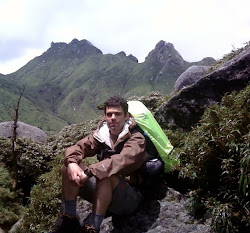February 13-15 is a three-day weekend to celebrate Seollal, the Korean Lunar New Year. It is a big holiday: almost all Koreans spend one of the days with their closest family, and sometimes visit different sides of the family on different days. Many Koreans also dress in the traditional Korean attire, known as hanbok. I was lucky to have a Korean friend invite me to share the traditional meal with her family. I arrived around 9:00 (today, Sunday) in time to observe Sandra's brother and nephew doing bowing rituals. They had a table at the side of the room set with plenty of fruits, vegetables, and other foods, all carefully arranged on small goblet-like serving platforms especially designed for the occasion; and some candles and incense. The men face the setting and perform several kneeling bows and one standing bow. Her nephew performed the same sequence several times, while I only observed her brother do it once. I understand this is in honor of ancestors. Then, they cleared the table, brought it to the middle of the room and set it with plenty of panchan (small plates of food everyone shares, using chopsticks to pick up the food from the dishes) such as kimchi, bean sprouts, spinach, small strips of cooked meat, and fried zucchini. I sat at the table (on the floor, of course) with the brother and nephew while Sandra and brother's wife served the doekkguk, which is like a starchy stew of small rice "dumplings" (not really the right word) and small pieces of meat and veggies, served with a bowl of rice on the side. Doekkguk is the traditional meal eaten on Seollal. The ladies sat down, and the only thing still missing was the baekseju, an alcoholic drink like soju except sweeter and flavored with herbs (and therefore more palatable). The name means something like "hundred years' wine" and is supposed to stretch your life span to as many years. Attempting to observe correct drinking ritual, I followed the toasts of the uncle over the course of the meal and downed several shot-sized glasses. The early hour did not seem to prevent anyone from partaking - except, of course, the teenaged nephew.
A bit after 11, Sandra and I departed for Gyeongbokgung (Gyeongbuk Palace), which is in Seoul, about an hour and 1/2 away on the bus and subway. The architecture of the Palace was the same traditional Korean building style I've observed in Buddhist temples, right down to the color patterns on the wood. The style strikes me as simple yet graceful: the larger features such as the sweeping roofs are eloquent without breaking into ornament, which is reserved for an occasional small detail in the most important buildings. (See the photo of the figures decorating the tile roof.) It was a pretty cold day and also the paths around the buildings were muddy, but we still had an enjoyable time. In one wing of the palace they had some traditional Korean living spaces that were unfurnished but still bright and cozy, with wood floors and sliding panels dividing the rooms; actually the best thing about the rooms was that they had heated floors. (Amazingly, heated floors is a building practice that goes back a long time in Korea. At the back of palace, emerging from a grassy mound was a row of nicely fashioned, large brick chimneys: these provided ventilation for the under-floor fires.) So after a time we wandered down to Insadong, a nearby neighborhood with lots of shops and coffee/tea houses. I bought some cheap but nice paper hangings to cover the ugly walls in my apartment. Following that, we found a spot to enjoy some tea before heading home for the day.
Tomorrow, a rare Monday free from teaching, the plan is to head to a small island not far from Seoul with some of the people from the Korean hiking club. Only this time, the hike will only be four hours (and nowhere near as cold!), and we'll spend most of the day eating and wandering around. Hopefully it will be a relaxing way to start the week. I'll keep you posted.




